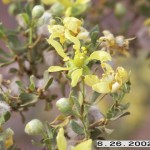Creosotebush, Creosote Bush, Greasewood
Larrea tridentata (DC.) Coville
Zygophyllaceae (Caltrop family)
Description
An evergreen, aromatic shrub in the Caltrop family, Creosote Bush generally grows from 3 to 6 feet or 0.9 to 1.8 m high and sometimes reaches up to 11 feet or 3.5 m. It is extremely shallow-rooted and drought-tolerant. When mature, the stems are rough and dark gray to black. Young twigs are brown and flexible with large, dark nodes that give the plant a joint appearance. The branched stems form small, aromatic leaflets measuring from 1/5 to 2/5 long. The leaves of Creosote Bush are dark green, pointed at the tips, compound, often sticky to the touch, and situated in opposite pairs on the stem. If rainfall is adequate, yellow flowers occur from March to September. The flowers are small, prolific, and have 5 petals, 10 stamens, and 1 pistil. Flowers are followed by fluffy and white fruit. Creosote provides poor forage for livestock and wildlife, but many livestock and wildlife species will bed down under the shrub as their only source of shade in the desert. Some reports state that consuming Creosote Bush may be fatal to sheep, but other researchers have treated the shrub with chemicals to make it more palatable. Small mammals use it as shelter and will browse its forage or consume its seeds. Nectar is used by insects, and its fruit may be consumed by birds.Habitat
Creosote Bush is commonly found in shallow soils with underlying hardpan (a layer of hard soil or clay) in the Trans-Pecos Region of Texas. Its distribution includes West Texas to Utah, Arizona, California, and South to Central Mexico. Habitats include flat, arid locations, desert grasslands, sand dunes, gentle slopes, arroyos, and xeroriparian areas. Creosote’s distribution may be controlled by its higher level of soil oxygen requirement.Images
Plant Characteristics
Flower Color: Yellow
Seed Type: Fruit/Berry
Duration: Perennial
Stem Texture: Hairless/Smooth
Growth Habit: Shrub (Woody)
Season: Warm
Distribution
 : 06 - South Texas Plains, 07 - Edwards Plateau, 09 - High Plains, 10 - Trans-Pecos
: 06 - South Texas Plains, 07 - Edwards Plateau, 09 - High Plains, 10 - Trans-Pecos
Distributions
Distribution refers to the ecological region in Texas that a plant has been found. You can also view a clickable map.
Book: Brush and Weeds of Texas Rangelands (B-6208)
Collection: Brush and Weeds






